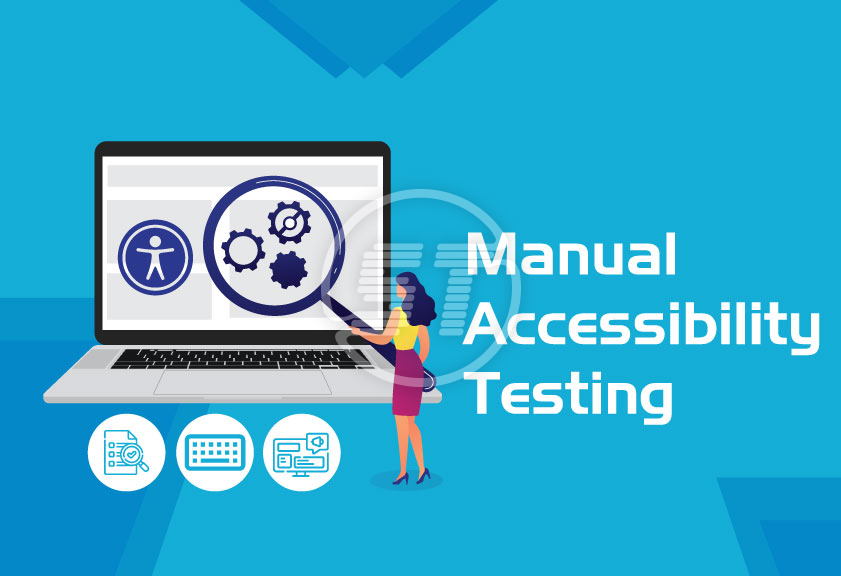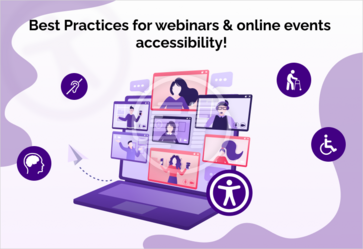“Testing is the art of finding a black box and making it sing”
The sentence says it all!
The aim of accessibility testing is to identify and address obstacles that prevent people with disabilities from completely using and interacting with a product or service. Website accessibility testing assess if it is usable by everyone.
Testing protocols must include automated and manual testing methods to ensure maximum availability of web content to everyone. There are several accessibility issues in respect to compliance standards which only could be verify by manual testing which is an essential to ensure that the solution is usable for visitors with specific disabilities.
The purpose of running manual accessibility test is to review all these facets thoroughly because automated accessibility testing tools check some areas of website/application but not in detail. For example,
- Color contrast of text on a simple background; gradients and image background can’t be tested.
- Existence of headings, lists, and landmarks, but their proper mark-ups are hard to test via automated tools.
- ARIA presence can be detected but their usage cannot be.
- Existence of Alt text for images; however, only manual testing can ensure meaning alt-text and images are non-decorative.
- Keyboard focus can be checked but elements that are missing focus and if focus order makes sense or not, cannot be tested.
- Automated testing detects video element; but can’t detect alternative media (such as captions and transcripts) are present.
- iFrame title can be detected; but the focus order with logical sense and focus indicator visibility can’t tested with automated tools.
- When you specify a valid language on your site, screen readers can correctly display text. Our test checks whether a valid language has been specified.
- Automated accessibility testing tools can’t detect language specific issues. For quality and accuracy of translations and localizations, manual testing is required.
Evaluate your website accessibility utilizing our free online website accessibility checker tool. This tool helps identify barriers that might prevent users with disabilities from fully enaging with content.
Manual website accessibility testing and its purpose!
Manual website accessibility testing reviews all aspects of website processes. It includes,
- Testing for screen reader compatibility to make sure the website content can be accessed while reading aloud and is understandable.
- Website keyboard navigation testing ensures maximum accessibility for users who cannot use a mouse.
- Testing visual elements and utilize tools such as screen magnification or browser zoom to review the website or app accessibility.
- Testing video/audio content ensures a similar kind of experience for all users even if someone turns off their speakers and microphones.
- Reviewing embedded media to make sure its accuracy for closed captions.
- Checking if website is working effectively on multiple device sizes and at different resolutions or not.
- Website testing for each success criteria of WCAG standards for various disabilities.
How to test website accessibility manually?
There are several manual accessibility audit tools and techniques available when it comes to digital accessibility of web page or app. The major focus areas include keyboard functionality, visually focused reviews, and content checks.
Before beginning manual testing, consider few questions like:
1. How often should I manually test?
It depends on how often changes will be made to the website. Generally, manual testing is a part of the update process. So, whenever there are impactful changes, we suggest doing a comprehensive manual test annually.
2. How many pages should I test manually?
The time and resource investment are the most impactful thing to answer this. For websites, manual testing of web page templates could be the efficient way to remediate issues on every page that uses a template. Another way is to select pages based on the top goals for your website. For example,
- Home page
- Product or service-based content pages
- Important pages with forms
- Shopping cart and checkout pages, and more.
3. How will I document or report issues and its fixes while testing accessibility manually?
We recommend creating an ADA web accessibility audit report which incorporates web accessibility audit and evaluation process, initial evaluation result, failed guidelines, and actions taken to provide remediation.
Components to pay attention for manual accessibility testing are:
Content testing
- Headings uniqueness and description, >h1>, >h2>, usability order, language, etc. should be checked.
- Alt text for images is mandatory. Also, embedded text must be represented somewhere in the body text or alt text.
- The color contrast ratio ought to be 4.5:1 and the error message should not only rely on colors.
- Table data must have apt headers, rows, columns and the table should only be used for tabular data in the content.
- Required zoom-in is a minimum of 200%.
- Forms controls are required to have proper labels.
Keyboard navigation
All interaction elements are required to be selected and activated via keyboard.
For example,
- Is focus always visible using the keyboard or do you lose track?
- Are focus colors suitable for color blinds?
- Moving to different pages using a navigation menu is possible or not?
- Is skipping between links and content happening easily?
- Are you able to close sudden-appearing pop-ups?
- Additional features such as maps, sliders, audio players, etc. can be interacted or not?
- Is filling and submitting a form seamless?
- Can actions, specially completing purchases be done or not?
Screen reader
Screen reader testing understands accessibility issues related to reading order, dynamic content, and other interactive components is mandatory.
Three common screen readers that should be tested for accessibility are VoiceOver, NVDA, and JAWS. If you identify any confusing or wrong sound such as if links are unclear, accordions with confusing interactions, if the focus does not move to the content inside the tab, if the content is not available immediately after taking an action, and if media is playing automatically, fix the issues on priority.
Manual website accessibility testing tools
- WebAim Contrast Checker (https://webaim.org/resources/contrastchecker/) – The tool helps test color contrast as per WCAG 2.0 level AA guidelines, which is 4.5:1 for normal text and 3:1 for larger text. For level AAA, it is 7:1 and 4.5:1 respectively.
- Seigemedia Contrast Checker (https://validator.w3.org/) – It is also used for testing color contrast.
- HTML validator (https://validator.w3.org/) – Mark-up validity of all web documents in HTML, XHTML, MathML, SMIL, etc. can be checked using this tool.
- CSS validator (https://jigsaw.w3.org/css-validator/) – To test a CSS style sheet embedded in an HTML document, CSS validator is used.
- AWS (Job Access with Speech) (https://www.freedomscientific.com/Products/software/JAWS/) – It is a screen reader that provides content translation into speech or braille for visually impaired users. Its compatibility with website is important.
- NVDA (https://www.nvaccess.org/download) – Similar as JAWS.
- iPhone VoiceOver – This tool is mainly for iPhone users that helps to translate website text into speech.
Manual website accessibility testing evaluates websites on various facets suggested by W3C to identify even a minute accessibility barrier to provide a real picture of website compliance. Thus, to ensure maximum web accessibility or compliance, both automated and manual testing is suggested.
We provide 360° website accessibility audit including automated, manual, and assistive technology for WCAG 2.1, WCAG 2.2, ADA, and Section 508 compliance! Once we identify the gaps, we provide website accessibility compliance and remediation plan / roadmap which includes key findings, pass/fail status.
Our comprehensive website accessibility remediation services are available with a custom process to meet individual organization needs. Reach out hello@skynettechnologies.com to know more.


